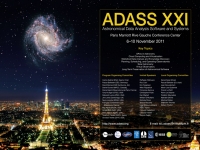Harro Verkouter (Joint Institute for VLBI in Europe)
Abstract
The Erlang programming language has been around
for over twenty years. It is a functional language with several useful
features not generally found in others. Transparent and lock-free
multi-core as well as multi-machine concurrency, fault tolerance,
binary data encoding and decoding, hot code swapping and good support
for I/O to allow communication with other systems are amongst its main
features.
This is in direct contrast with other functional
languages. Erlang's I/O model closely resembles procedural languages
by allowing the Erlang runtime to be impure in this restricted
subsystem, outside the user's control. User code remains pure:
statements have no side effects, which allows for lock-free
multi-processing.
Erlang has been designed from the start
to be fault tolerant. Its designers realised this by providing an
infrastructure which allows a system to recover from unexpected events
by automatically restarting, or, in case of hardware failures,
migrating services on-the-fly to redundant hardware.
The
Joint Institute for VLBI in Europe (JIVE) is leading an international
project called the UniBoard, that has designed and produced a generic,
high-performance, FPGA-based computing platform for radio astronomy.
The development at JIVE of a VLBI correlator based on this board is
currently ongoing.
Each board is fitted with eight
state-of-the-art FPGAs delivering in total 0.5 TFLOPS of processing
power and 320Gbps aggregate I/O capacity. Each FPGA of each UniBoard
can be controlled via its ethernet link. Multiple data sources send
radio astronomical data to the UniBoard for processing. These nodes
must also be controlled.
A number of programming languages
and systems (Python, C, C++, Java) were carefully investigated to
determine their suitability for the implementation of a UniBoard
monitoring and control system (MAC). Although all programming
languages obviously have their pros and cons, we found the number of
built-in features and libraries it ships with, directly applicable to
such an implementation, quite remarkable. After extensive tests of
Erlang through a pilot project, the decision was made to use it for
both the UniBoard MAC and an overall correlator control
system.
In this talk I will give an outline of the UniBoard
project and its results, and I will illustrate our experience with
Erlang by describing one of the significant subsystems, the UniBoard
MAC, which handles the concurrent control of multiple embedded
systems.Poster in PDF format
Paper ID: P158
Poster Instructions
|

